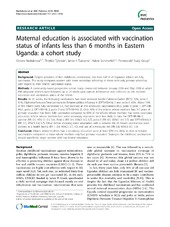| dc.description.abstract | Background: Despite provision of free childhood vaccinations, less than half of all Ugandan infants are fully vaccinated. This study compares women with some secondary schooling to those with only primary schooling with regard to their infants' vaccination status. Methods: A community-based prospective cohort study conducted between January 2006 and May 2008 in which 696 pregnant women were followed up to 24 weeks post partum. Information was collected on the mothers' education and vaccination status of the infants. Results: At 24 weeks, the following vaccinations had been received: bacille Calmette-Guérin (BCG): 92%; polio-1: 91%; Diphteria-Pertussis-Tetanus-Hepatitis B-Haemophilus Influenza b (DPT-HB-Hib) 3 and polio-3: 63%. About 51% of the infants were fully vaccinated (i.e., had received all the scheduled vaccinations: BCG, polio 0, polio 1, DPT-HB-Hib1, polio 2, DPT-HB-Hib 2, polio 3 and DPT-HB-Hib 3). Only 46% of the infants whose mothers' had 5-7 years of primary education had been fully vaccinated compared to 65% of the infants whose mothers' had some secondary education. Infants whose mothers had some secondary education were less likely to miss the DPT-HB-Hib-2 vaccine (RR: 0.5, 95% CI: 0.3, 0.8), Polio-2 (RR: 0.4, 95%CI: 0.3, 0.7), polio-3 (RR: 0.5, 95%CI: 0.4, 0.7) and DPT-HB-Hib-3 (RR: 0.5, 95%CI: 0.4, 0.7). Other factors showing some association with a reduced risk of missed vaccinations were delivery at a health facility (RR = 0.8; 95%CI: 0.7, 1.0) and use of a mosquito net (RR: 0.8; 95%CI: 0.7, 1.0). Conclusion: Infants whose mothers had a secondary education were at least 50% less likely to miss scheduled vaccinations compared to those whose mothers only had primary education. Strategies for childhood vaccinations should specifically target women with low formal education. | en_US |

